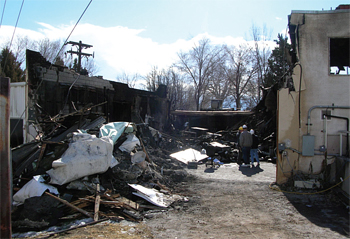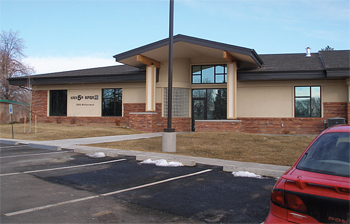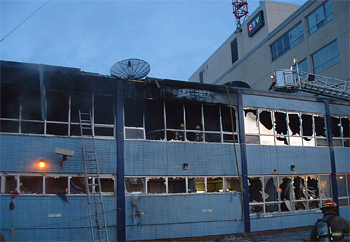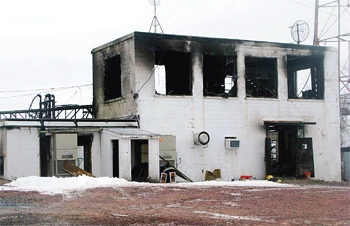Out of the ashes
OTTAWA
Fires are the bread-and-butter of local TV station news. But sometimes irony strikes, and the TV station itself is damaged or even destroyed by fire. When this happens, engineers and managers have to think fast to resume regularly scheduled programming as soon as possible. Here are three stories of how three stations did it.
STALIN'S HELP

Two years later, the cause of the KREX studio fire is still unknown. On Sunday Jan. 20, 2008, fire utterly destroyed the studios of KREX-TV in Grand Junction, Colorado. No one knows how it started in the Hoak Media-owned station, but it didn't take long for flames to rip through the KREX building—a 1930s' vintage Art Deco block landmark built for sister station KREX-AM, causing $6 million in damages.
To make matters worse, the fire didn't just knock CBS-affiliate KREX off air. It also blacked out KREY (CBS), KREG (CBS), KFQX (FOX) and KGJT (MyTV). This is because all five stations' signals were managed by KREX's Master Control. The only saving grace is that none of the five employees on duty were injured.
"Even today, we don't know what happened," said KREX-TV Chief Engineer Philip Mowbray. "We had the Super Bowl scheduled in two weeks' time. When the fire hit, we thought that we'd never get back on air in time."
Despite the total devastation of the one-story KREX station building, Mowbray and his staff—aided by local broadcasters and helpful vendors such as Har-ris—were able to get KREX and its sister stations back on air in just over a week.

KREX’s new studios today In a way, it was Soviet dictator Josef Stalin who deserved partial credit for KREX's quick functional recovery. In the 1950's, when the threat of nuclear at-tack prompted thousands of Americans to build bomb shelters, KREX engineers built their own bomb shelter in the station's basement; complete with 12-inch thick concrete walls and fireproof doors.
Once the threat of nuclear war had receded, "we used the bomb shelter to house all of our digital conversion equipment; the encoders, multiplexer, one of our transmitters and our network racks," Mowbray said. "As a result, they were protected from the fire. We were able to retrieve the equipment and install them in a couple of consumer garden sheds and a 12-foot by 60-foot construction trailer. And yes, they all worked when we plugged them in!"
After the fire was over, the trailer and garden sheds became master control/technical operations and transmitter/equipment sheds respectively. Studio space was provided by local PBS affiliate KRMJ, while "a local community college lent us a classroom as a newsroom," Mowbray said. "Harris really pitched in: they brought down their full complement of demo equipment, and let us pick what we needed while leaving the paperwork for later." This included Harris HD/SDI signal analyzers and multiformat monitors. KREX also bought a Ross Video Synergy switcher, a Wheatstone audio console, and Sony HD studio/ENG cameras.
By August 1, 2009, KREX's new station had been built behind the original structure, which had been demolished. Today, the fire is just a vivid memory. But one has to wonder: Does Joseph Stalin truly deserve some credit for saving KREX? After a pregnant pause, Phillip Mowbray laughed heartily and replied, "that's abso-lutely right!"
DIDN'T SKIP A BEAT
The 50 year-old, two-story building that houses the CTV Ottawa (Canada) newsroom and studio is a landmark. It was here that Canada's first commercial TV sta-tion (originally known as CJOH) opened in 1961. So when fire ripped through the second floor newsroom early Sunday morning, Feb. 7, 2010, it wasn't just the city's top-rated newscast that was devastated: It was the vast majority of Ottawa TV viewers.

Fire ripped through the second floor newsroom at CTV Ottawa early Sunday morning, Feb. 7, 2010. Ironically, most of these viewers saw video of the fire on the Sunday night newscast... on CTV Ottawa. The reason: Thanks to earlier cutbacks at its sister station "A Channel," there was a working TV newsroom/on-air studio available in the downtown core of Canada's capital city. A Channel's 6 p.m. and 11 p.m. news had originated from here, until being cancelled in March 2009. (The studio is still used to produce a four-hour morning show, six days a week.)
As a result of this availability, "we didn't miss a newscast," said Louis Douville, CTV Ottawa's vice president/GM. "Together, we worked some minor miracles and managed to pull ourselves together for the 11:30 p.m. news."
"Minor miracles" is a fair way to describe it. For one thing, CTV Ottawa's producers were not accustomed to A Channel's automated news production systems. Meanwhile, the news staff were crammed into whatever space was available, while camcorders were scrounged from wherever they could be found. "The only cameras that we still had were those that were out with staff," Douville said. "But thanks to the teamwork between the two stations, the only difference our viewers noticed was the set."
Note: At press time, CTV Ottawa was still working out of the A Channel facility. Due to the instability of the CTV Ottawa building, station staff have yet to enter it to see what has been lost and what might be saved.
WVIA: A FRIEND IN NEED

When WVIA’s transmitter building burned down in February, neighbour station WNEP loaned them a transmitter to get back on the air. PBS member station WVIA-44 of Pittston, Pa. has its UHF transmission site on Penobscot Mountain. It is a very remote location with access from a single dirt road—which explains why firefighters responded slowly when fire broke out on Feb. 12, 2010. "Some contractors were removing our old analog transmitter and associated equipment, when a voltage regulator started arcing," said Joe Glynn, WVIA's vice president of engineering. "The wall and ceiling tiles caught fire, and the fire extinguishers we had weren't enough to put it out. By the time the fire department and their water tankers arrived, the entire building was engulfed."
It didn't take long for WVIA's transmission plant and that of sister radio station WVIA-FM to be totally gutted. Yet WVIA was soon back on air, thanks to the gen-erous assistance of local ABC affiliate WNEP. That station's initial DTV signal had been transmitted on Channel 49; a slot WNEP vacated in favor of channel 50 during the DTV transition. As a result, "WNEP had an unused digital frequency allotment and a Channel 49 transmitter available, which they graciously loaned to us," Glynn said. "This allowed us to get back on air to 95 percent of our viewers within two days!" (WVIA-FM was restored at 10 percent power initially; climbing to 70 percent within a week using a new transmitter.)
WVIA might have returned to air sooner had it not run into issues with its destroyed transmitter site STL. "Since we were an early DTV adopter, we are still using a 2001 Nucomm STL that is now obsolete," he explained. "Fortunately, Nucomm sent some staff down here with parts, and we managed to put together an STL re-ceiver that was compatible with what we use at our studio."
At press time, WVIA was still picking up the pieces from its transmitter building fire. But thanks to WNEP's corporate good citizenship, the station itself was restored fast; proving that a friend in need truly is a friend indeed. "To say that we are eternally grateful is an understatement," said Joe Glynn. "WNEP was there when we needed them, and we appreciate it."
The professional video industry's #1 source for news, trends and product and tech information. Sign up below.
James Careless is an award-winning journalist who has written for TV Technology since the 1990s. He has covered HDTV from the days of the six competing HDTV formats that led to the 1993 Grand Alliance, and onwards through ATSC 3.0 and OTT. He also writes for Radio World, along with other publications in aerospace, defense, public safety, streaming media, plus the amusement park industry for something different.

